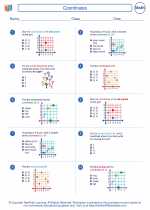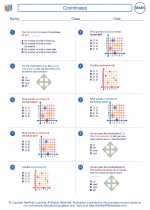Coordinates -> cartesian coordinates
Cartesian Coordinates
Cartesian coordinates are a system for representing points in a plane using two perpendicular axes, typically labeled x and y. This system was developed by René Descartes and provides a way to precisely locate points in a two-dimensional space.
The Coordinate Plane
The coordinate plane consists of two perpendicular number lines, the x-axis and the y-axis. The point where the two axes intersect is called the origin, and is represented by the coordinates (0, 0).
The x-axis is the horizontal axis, with positive values to the right of the origin and negative values to the left. The y-axis is the vertical axis, with positive values above the origin and negative values below.
Coordinates of a Point
To represent a point in the coordinate plane, we use an ordered pair of numbers (x, y), where x is the distance from the y-axis (positive to the right, negative to the left) and y is the distance from the x-axis (positive above, negative below).
Plotting Points
To plot a point on the coordinate plane, start at the origin and move horizontally (left or right) the number of units given by the x-coordinate, then move vertically (up or down) the number of units given by the y-coordinate. The point where you end up is the location of the plotted point.
Study Guide
- What are Cartesian coordinates?
- What are the two perpendicular axes in the coordinate plane?
- What is the origin in the coordinate plane?
- How do you represent a point in the coordinate plane?
- How do you plot a point on the coordinate plane?
After studying this topic, you should be able to understand how to represent and locate points in a two-dimensional space using Cartesian coordinates. Practice plotting points and identifying coordinates to strengthen your understanding of this concept.
.◂Math Worksheets and Study Guides Fourth Grade. Coordinates

 Worksheet/Answer key
Worksheet/Answer key
 Worksheet/Answer key
Worksheet/Answer key
 Worksheet/Answer key
Worksheet/Answer key
